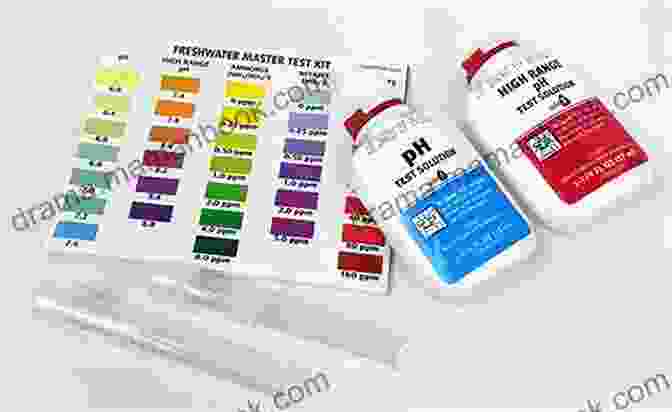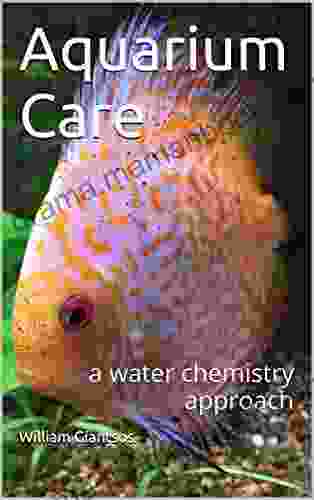Navigating the Complexities of Aquarium Water Chemistry: A Comprehensive Guide


Aquarium water chemistry is a crucial aspect of maintaining a healthy and thriving aquatic environment for your fish and other aquatic creatures. Understanding the different parameters that affect water quality and how to maintain optimal levels is essential for ensuring the well-being of your aquarium inhabitants. This comprehensive guide will delve into the complexities of aquarium water chemistry, providing you with the knowledge and tools necessary to maintain a balanced and stable aquatic ecosystem.
4 out of 5
| Language | : | English |
| File size | : | 10252 KB |
| Text-to-Speech | : | Enabled |
| Screen Reader | : | Supported |
| Enhanced typesetting | : | Enabled |
| Print length | : | 19 pages |
| Lending | : | Enabled |
Understanding Key Water Chemistry Parameters
The water chemistry of an aquarium is influenced by several key parameters, each playing a vital role in the overall health of the system. These parameters include:
1. pH: Acidity or Alkalinity
pH is a measure of the acidity or alkalinity of water, and it ranges from 0 to 14. A pH of 7 is neutral, while values below 7 indicate acidity, and values above 7 indicate alkalinity. Most aquarium fish prefer a pH between 6.5 and 7.5, although some species may have specific pH requirements.
2. Alkalinity (KH): Acid-Neutralizing Capacity
Alkalinity measures the water's ability to neutralize acids and maintain a stable pH. It is expressed in units of carbonate hardness (KH) and is important for preventing pH crashes due to acid buildup in the water.
3. Hardness (GH): Calcium and Magnesium Content
Hardness measures the amount of dissolved calcium and magnesium ions in the water and is expressed in units of parts per million (ppm). Some fish species prefer hard water, while others thrive in soft water.
4. Ammonia: Nitrogenous Waste
Ammonia is a toxic substance produced by the breakdown of organic matter in the aquarium. It is converted into nitrite and nitrate by beneficial bacteria, but high levels of ammonia can be harmful to fish.
5. Nitrite: Intermediate Nitrogenous Waste
Nitrite is an intermediate product of the ammonia conversion process and is also toxic to fish. It is important to monitor nitrite levels and take steps to reduce them if they become elevated.
6. Nitrate: Final Nitrogenous Waste
Nitrate is the final product of the nitrogen cycle and is less toxic to fish than ammonia and nitrite. However, high levels of nitrate can still be detrimental to aquatic life.
Maintaining Optimal Water Chemistry Levels
Maintaining optimal water chemistry levels is essential for ensuring the health and well-being of your aquarium inhabitants. Here are some tips:
1. Regular Water Testing:
Regular water testing is crucial to monitor water chemistry parameters and identify any potential issues. Invest in a reliable test kit and test your water frequently, especially when introducing new fish, plants, or decorations.
2. Water Changes:
Regular water changes are essential to remove waste products and replenish minerals. Aim to perform water changes of 10-25% of the tank volume once or twice a week.
3. Filtration:
A good filtration system is vital for removing waste particles, maintaining clear water, and supporting beneficial bacteria. Choose a filter appropriate for the size of your tank and its biological load.
4. Buffering:
Buffering agents can help stabilize pH and prevent fluctuations. Consider using products like baking soda, crushed coral, or commercial buffers to maintain a stable pH in your aquarium.
5. Adding Minerals:
If your tap water lacks sufficient minerals for your fish species, you may need to add minerals to the water using products like calcium supplements or GH booster.
Troubleshooting Common Water Chemistry Problems
Despite diligent maintenance, water chemistry issues can arise in aquariums. Here are some common problems and solutions:
1. High Ammonia:
* Increase water changes and clean the filter. * Add beneficial bacteria supplements. * Avoid overfeeding and overcrowding.
2. High Nitrite:
* Increase aeration and water changes. * Add more beneficial bacteria. * Check for dead or decaying organic matter in the aquarium.
3. High Nitrate:
* Increase water changes. * Add live plants to absorb nitrates. * Consider using a nitrate-reducing filter media.
4. Low pH:
* Add buffering agents like baking soda or crushed coral. * Use CO2 injection carefully to avoid pH drops. * Check for acidic substances in the water, such as tannic acid from driftwood.
5. High pH:
* Add acidic substances like peat moss or almond leaves. * Perform water changes with low-pH water. * Avoid using medications that raise pH.
Additional Considerations
In addition to the key water chemistry parameters discussed above, there are several other factors that can influence water quality and the health of your aquarium:
1. Temperature:
Temperature is a critical factor for maintaining optimum fish health and can also affect water chemistry parameters like dissolved oxygen levels.
2. Dissolved Oxygen:
Dissolved oxygen (DO) is essential for fish respiration and should be maintained at levels above 5 ppm. Adequate aeration and water circulation can increase DO levels.
3. Chlorine and Chloramine:
Chlorine and chloramine are disinfectants often added to tap water and can be harmful to fish and beneficial bacteria. Use water conditioners to remove these chemicals before adding water to your aquarium.
Aquarium water chemistry is a complex subject that requires careful monitoring and management to maintain a healthy and stable aquatic environment. By understanding the key parameters that affect water quality and implementing the appropriate maintenance practices, you can create an optimal environment for your fish and other aquatic creatures to thrive. Remember to test your water regularly, make gradual changes to water chemistry parameters, and seek professional advice when necessary. With dedication and a thorough understanding of these concepts, you can ensure the long-term well-being of your aquarium inhabitants.
4 out of 5
| Language | : | English |
| File size | : | 10252 KB |
| Text-to-Speech | : | Enabled |
| Screen Reader | : | Supported |
| Enhanced typesetting | : | Enabled |
| Print length | : | 19 pages |
| Lending | : | Enabled |
Do you want to contribute by writing guest posts on this blog?
Please contact us and send us a resume of previous articles that you have written.
 Top Book
Top Book Novel
Novel Fiction
Fiction Nonfiction
Nonfiction Literature
Literature Paperback
Paperback Hardcover
Hardcover E-book
E-book Audiobook
Audiobook Bestseller
Bestseller Classic
Classic Mystery
Mystery Thriller
Thriller Romance
Romance Fantasy
Fantasy Science Fiction
Science Fiction Biography
Biography Memoir
Memoir Autobiography
Autobiography Poetry
Poetry Drama
Drama Historical Fiction
Historical Fiction Self-help
Self-help Young Adult
Young Adult Childrens Books
Childrens Books Graphic Novel
Graphic Novel Anthology
Anthology Series
Series Encyclopedia
Encyclopedia Reference
Reference Guidebook
Guidebook Textbook
Textbook Workbook
Workbook Journal
Journal Diary
Diary Manuscript
Manuscript Folio
Folio Pulp Fiction
Pulp Fiction Short Stories
Short Stories Fairy Tales
Fairy Tales Fables
Fables Mythology
Mythology Philosophy
Philosophy Religion
Religion Spirituality
Spirituality Essays
Essays Critique
Critique Commentary
Commentary Glossary
Glossary Bibliography
Bibliography Index
Index Table of Contents
Table of Contents Preface
Preface Introduction
Introduction Foreword
Foreword Afterword
Afterword Appendices
Appendices Annotations
Annotations Footnotes
Footnotes Epilogue
Epilogue Prologue
Prologue Will Jordan
Will Jordan Jo Nesbo
Jo Nesbo Tom Murry
Tom Murry Todd Miller
Todd Miller Matthew Sweeney
Matthew Sweeney Milton Carroll
Milton Carroll Katie Ellison
Katie Ellison Thorsten Zeller
Thorsten Zeller Michelle Terrell
Michelle Terrell Gravity Goldberg
Gravity Goldberg Emma Goldrick
Emma Goldrick Tony Harrison
Tony Harrison Maria Massi Dakake
Maria Massi Dakake Elton T E Barker
Elton T E Barker Rupnarayan Bose
Rupnarayan Bose Shell Isenhoff
Shell Isenhoff Richard Moskowitz
Richard Moskowitz Amy Lowell
Amy Lowell Amy Perez Ms Psychology
Amy Perez Ms Psychology Blake J Harris
Blake J Harris
Light bulbAdvertise smarter! Our strategic ad space ensures maximum exposure. Reserve your spot today!

 Federico García LorcaEmbroidery: An Art Form for Personal Empowerment and Magical Embellishment
Federico García LorcaEmbroidery: An Art Form for Personal Empowerment and Magical Embellishment Adam HayesFollow ·12.4k
Adam HayesFollow ·12.4k Winston HayesFollow ·10.5k
Winston HayesFollow ·10.5k Braeden HayesFollow ·7.7k
Braeden HayesFollow ·7.7k Alexandre DumasFollow ·2.5k
Alexandre DumasFollow ·2.5k Gary CoxFollow ·7.4k
Gary CoxFollow ·7.4k Billy FosterFollow ·11.1k
Billy FosterFollow ·11.1k Robbie CarterFollow ·10.2k
Robbie CarterFollow ·10.2k Christian CarterFollow ·2.6k
Christian CarterFollow ·2.6k

 Jesus Mitchell
Jesus MitchellThe Diabetics Menu: Your Low Carb Options
If you're living with diabetes, you may be...

 Danny Simmons
Danny SimmonsThe Sam Reilly Collection: A Treasure Trove of...
In the realm of...

 Vic Parker
Vic ParkerThe Shepherdess of Siena: The Extraordinary Life of Saint...
Catherine of Siena, known as the...

 Christian Carter
Christian CarterDive into the Mystical World of Meraki Syren: A Literary...
A Literary Odyssey Through the Depths...

 Eric Hayes
Eric HayesSimplest Method on How to Remove Credit Cards from Your...
Do you have multiple credit cards...
4 out of 5
| Language | : | English |
| File size | : | 10252 KB |
| Text-to-Speech | : | Enabled |
| Screen Reader | : | Supported |
| Enhanced typesetting | : | Enabled |
| Print length | : | 19 pages |
| Lending | : | Enabled |












